ARTIST ‘BIRTHS’ LAMPSHADES WITH CREATIVE PASSION
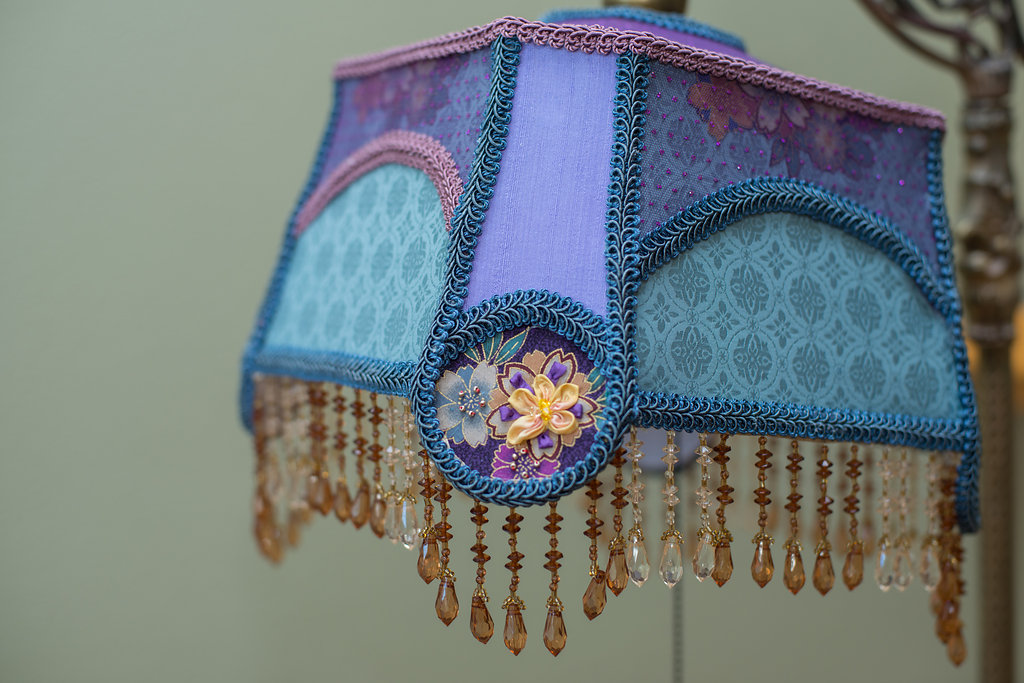
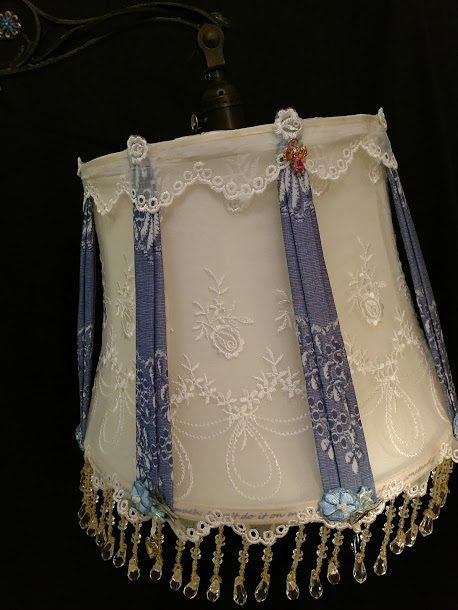
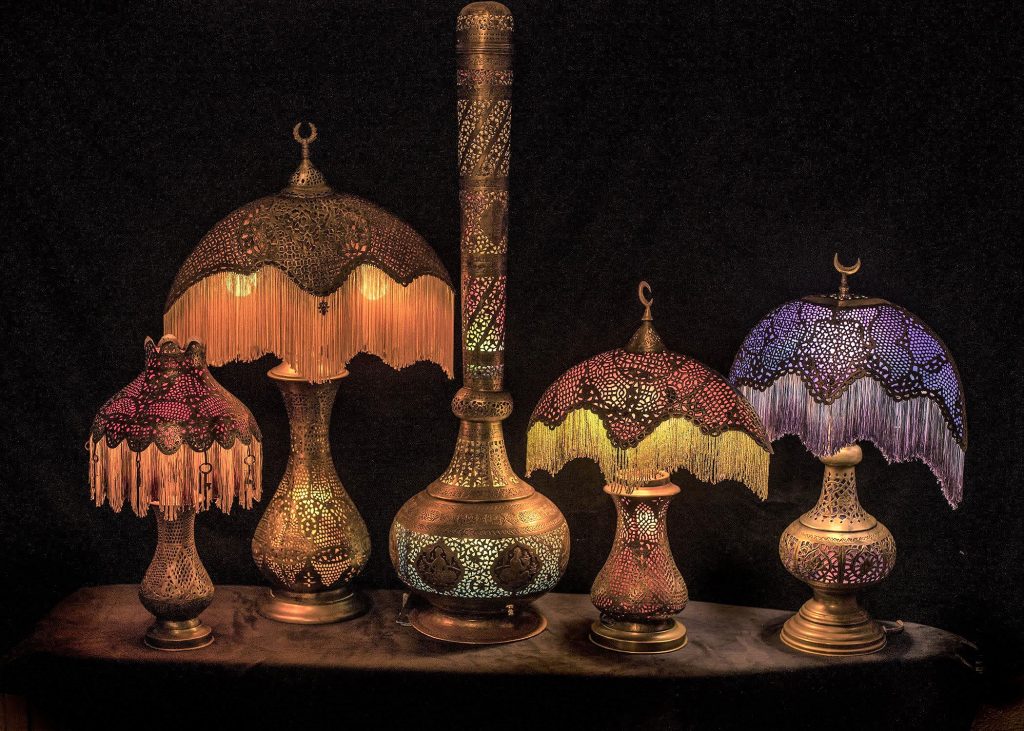
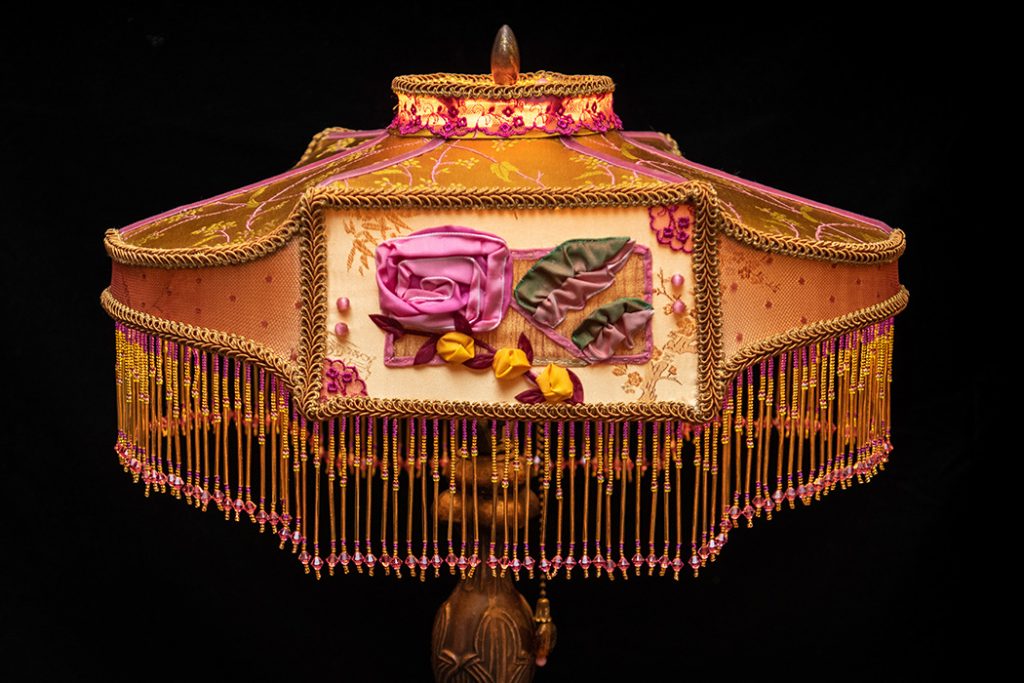
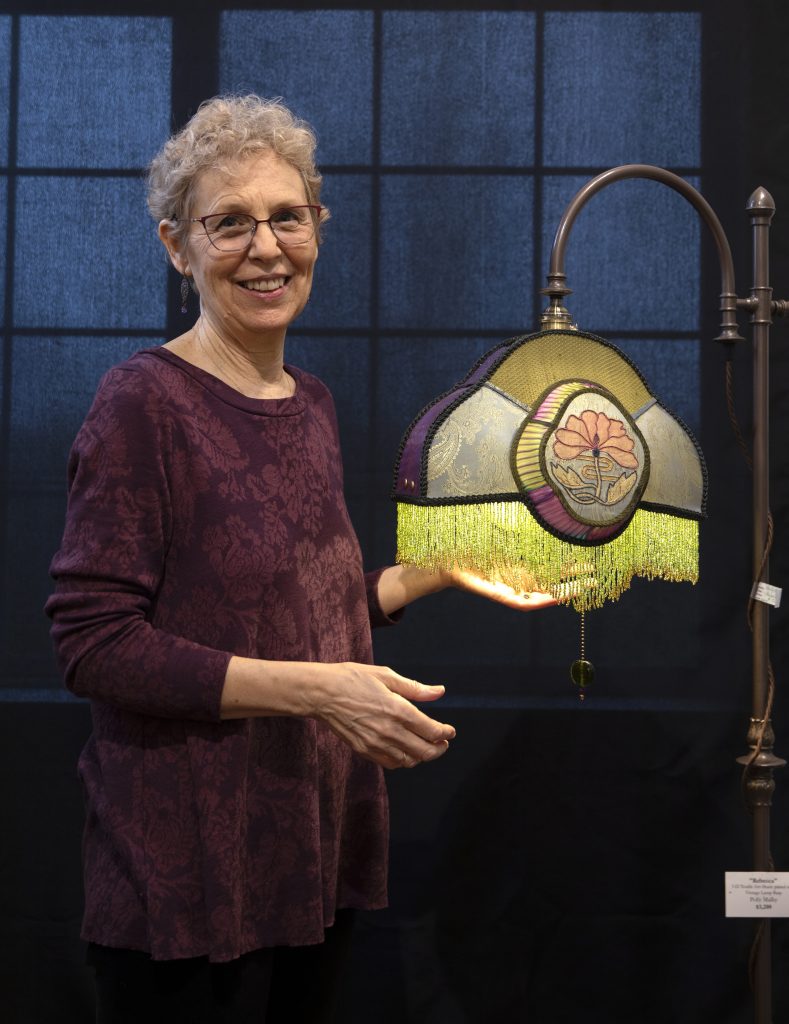
Polly Malby has lived an incredible life and career, traveling the U.S. and beyond working as a midwife and teaching the art of midwifery to the next generation, with threads of science, art, and faith woven into her story.
Now the Fairview-based artist harnesses her passion for birth, beauty and the wonder of life itself and uses it to create unique custom lampshades and lamp fixtures to shine a light in the world.
Her story began as the oldest of five siblings. Her father served in the U.S. Marines, so she and her family moved every couple of years and got to see different parts of the U.S., from Hawaii to Washington, D.C. to California and back again. She was good at making friends quickly, but it wasn’t easy to have lasting relationships, clearly.
Polly also grew up with a natural curiosity about babies and birth, which particularly alarmed her parents.
“I remember overhearing tidbits of stories my mother told when she thought I wasn’t listening about the difficulties she had during my birth and how she was not being treated well by the medical staff,” she recalled. “I was sure that I could improve upon the care she had received. I liked to help, and I wanted to put Band-Aids on anyone with a sore finger.”
She also had a deep compassion for animals and daydreamed about becoming a veterinarian.
Her father retired from the Marine Corps when she was 15, and it was most likely because he realized that his daughter was interested in every attractive young Marine on the base. The family landed in Medford, Oregon, and bought a house with a pond and a barn.
A CALLING IS BORN
“Daddy fancied himself a farmer, and one of the first things he did was buy a couple of weaner pigs,” said Polly. So, when she rode home on the school bus, the other kids would often say, “Hey, Polly, there go your pigs again.” They always seemed to end up over in the neighbor’s pear orchard, and so she would set her bags down and wrangle the little pigs back home.
The female pig’s name was Juneau, and once she grew big, Polly was warned not to get in the pen or she would be eaten alive – and she believed that warning. Her dad decided to breed Juneau without her knowledge, and she was annoyed that she had missed the process.
Juneau indeed became pregnant and her dad bought a book on how to care for a pregnant sow, which he kept in the top drawer of his dresser. Unbeknownst to him, Polly found the book it and read it cover-to-cover, dozens of times. Then, one beautiful spring evening, her parents went out and left her in charge of her younger siblings. At bedtime she decided to check on Juneau because earlier in the day she had been acting strange. It was warm, and the smell of the hay wafted through the air in a moonlit sky – and there lay Juneau, working hard to birth her piglets.
“She already had two, and those greedy little piglets were nursing like crazy with no assistance from me, so I ran into the house, and I got the book, the pail of water, the scissors, and the string, and ran back out,” Polly said. Juneau continued to push and strain for quite some time, but nothing new was happening.
Polly had read in the book that “piglets should arrive without undue delay” and wasn’t sure how long that wait should be. Surveying the hay and the barn rafters, she decided in that moment she alone was the one to help Juneau, dire warning or not. She climbed into the pen, scratched the sow’s butt, and washed her off with warm water – and soon realized the only way to help the mother was to reach inside and find out what was happening.
When she slid her hand in, she felt another piglet lodged sideways, like a brick. She pushed on one end, with a teeter-totter effect and out plopped the big piglet into her lap, followed by two more in quick succession. The newborn didn’t want anything to do with her; they knew where the food was.
“The book said to do this to the (umbilical) cord and that to the teeth, and the piglets weren’t having any of it,” Polly added. “When I tried to hold one down to attend to its cord, Juneau grunted, and I thought, ‘Okay, never mind.’ But Juneau was quite happy as long as I was scratching her butt, and pleased that I relieved her of the impacted piglet.”
A CAREER BEGINS
After Polly graduated high school in 1970 she studied nursing at Southern Oregon College (now University) in Ashland. In the summer before her junior year, she met the love of her life, Greg, and the two were married by Christmas. During her senior year one evening she noticed food left on the dining table and told Greg, “You know, babies don’t eat much.” He agreed – and soon she was pregnant. The couple had their first baby two weeks before her SOC graduation.
Within a few years, the couple had settled in Medford and become active members of the Baha’i religious community there. Founded in the 19th century, the Baha’i Faith teaches the worth of all the world’s religions and the unity of all people, and one of its central tenets is to be of service. Before long, Polly and Greg took up service work as a nurse and carpenter, respectively, and they moved to the Falkland Islands – a tiny U.K. territory off the southern tip of South America, about 250 miles from Argentina and nearly as close to the edge of Antarctica.
“A windy, cold place. Very, very British,” Polly said. “And I got to work with British midwives. They were these tall, bossy women, and I thought, ‘By golly, I want to be one of those.’ “
After four years of service work in the Falklands, Polly had had enough: She’d milked enough cows, collected enough eggs, baked enough bread, washed enough clothing by hand, and burned enough peat (used for fuel). She had gotten the itch to go back to school, ready to pursue midwifery training.
By then, she and Greg had had a second daughter and adopted another. They would settle in Jackson, Mississippi, and she was accepted in the University of Mississippi medical school and completed her training. Upon graduating, she served in one of three state-run charity hospitals there, with a staff of five certified nurse midwives and three physicians. The physicians oversaw the entire hospital, and the five midwives had the highest infant and maternal survival rate of any hospital in the state during their time working there. They cared for thousands of impoverished and underserved families whose access to good nutrition and housing was minimal.
“It was a challenging and wonderful clientele to care for, and be a part of,” said Polly. “This was nursing and midwifery care (more) typical of the 1930s, without modern equipment and backup. Your learning curve goes sky-high when you’re thrown into the trenches. But what you had were your skills, hands, and heart. It was an incredible experience for me as a brand-new midwife.”
In 1982, with Polly facing yet another Mississippi summer and a third pregnancy herself, the family headed back west and closer to relatives again. She worked in a small birth center in
Gold Beach, Oregon, for a year, then moved to Crescent City, California. She owned a private practice and did home births there another five years.
Somewhere during this time, Polly was asked randomly what she wanted to do when she grew up, and she replied that she would like to teach. Inspired to act on that, she won acceptance at Case Western Reserve University in Cleveland and completed her graduate work. Not long after, she was hired at Oregon Health and Science University as an assistant professor faculty midwife and would spend 18 years there, finally retiring in 2008.
A PASSION FOR ART
All along, Polly’s love of art remained as big a part of her life as nurturing and serving.
“The other piece that weaves in throughout my story is my sense of creativity and desire to make things beautiful and fun,” she said. “When I did midterms and final exams for my students, I made them like screenplays, and the students had to figure things out. Not just regurgitate information but show they had critical thinking skills, which was fun. I had former students come up to me many years later at conventions and say they still had those exams.”
At certain times of the year, she made a series of gifts for her students, such as a hollowed-out egg on which draws a picture of birth, or of a baby holding a mother’s hand. She made a golden speculum award one year and presented it to a fellow faculty member. “Then, of course, my daughters were getting older, and they needed prom dresses, wedding dresses, and wedding cakes,” she noted.
After that in 1998, they moved to Camp Angelos, an outdoor school on the Sandy River, so that Greg could take a position as the facilities manager. Greg was known as the ranger, she was known as the ranger’s wife, and they lived in the ranger’s cabin for 13 years. It was a wonderful experience for her at Camp Angelos to be a part of the storms, the weddings, the incredible music the outdoor school encouraged the kids to participate in, and the wonderful
Greek family that owned the camp. During this time Polly also sponsored a ladies’ tea meeting at Corbett Grange once a month. At each meeting, she found local experts to share all kinds of topics – from estate planning and financial management to improv, cooking, quilting, and painting. She’s continued her Corbett connections by volunteering weekly at the Helping Hands food distribution center and still does to this day.In 2015 Greg retired from Camp Angelos, and as empty nesters they moved to Fairview.
LIGHTING UP NEW TREASURES
Polly’s focus on lamps and shades came much more recently.
In 2015 when Greg retired, he took a secondary job at Hippo Hardware in Portland, which sells antique hardware and salvaged goods. One day he brought home a broken lampshade and asked Polly if she could do something with it, and she became excited and replied, “Are you kidding? silk, ribbons, colors, beads, yeah!” And since that moment, she’s been making custom lampshades and lamp fixtures, for eight years now.
Her lamps are featured at the Red Trillium Gallery in Troutdale, The Café Delirium in Gresham, and The Pendleton House B&B. Her handiwork can be seen at several McMenamins properties, such as Edgefield in Troutdale, The White Eagle Saloon & Hotel in Portland’s St. Johns neighborhoood and The Blue Moon Tavern in northwest Portland. Two of her lamps were purchased to be featured in a hotel scene for the television show “Billions.”
Polly said she draws inspiration from artists William Morris, Maxfield Parish, and Duffy Sheridan, as well as the Art Nouveau and Craftsman eras.
Clearly, her favorite type of lampshade project is creating heirloom and memorial lamp shades, as well as shades to commemorate special events such as weddings or anniversaries.
An example: She had an opportunity to create a shade in remembrance of a child that had died in a tragic accident. The mother had taken many years to unpack the boxes or get rid of anything that belonged to the victim. Finally, the mother gave her some clothing and charms that had belonged to the child and a newspaper clipping with a poem on it that the mother read at the funeral.
“I designed the lampshade thinking this mother would never be able to attend the child’s wedding, to watch them graduate, or welcome that child’s children,” said Polly. “I used strips of a blue dress to create a pocket for the mother to tuck in her child’s student body card and display that treasure, if she wished. The child’s soccer number was 2, so I included No. 2 charms with the others along the trim. I printed the poem from the newspaper clipping on a ribbon and incorporated it at the base of the shade just above the rim.
“And it was very subtle, but you could see the beautiful words from this poem as they ran around the shade if you looked closely. It was a very special project for me because I knew I was being helpful to that family.”
Polly loves to create shades that incorporate a bride’s colors, the flowers she picked out, the style on the wedding invitation, or the type of lace on her dress.
“People having a wedding spend a lot of time and money shopping for the right flowers, the right atmosphere and theme, and then the event is over, all the tablecloths get returned, the flowers wilt, and everything gets thrown out,” she said. “So, if I make a lampshade that incorporates all those beautiful elements, it helps to preserve the memory in a beautifully unique way.”
There is always a story attached to how she comes about her lamp-making supplies and how each piece comes together. For example, she was visiting the coast and encountered a
woman who was moving her antique shop and in that stash was a Chinese gentleman’s wedding skirt, from whish a previous owner had cut a large square out of the middle. To most people, the garment would be considered ruined and no longer useable – but not to her.
“It was made of this crispy, gold silk with perfect pleats and gorgeous hand embroidery throughout, and I’ve used it in several projects,” she said.
She loves repurposing old neckties because they come in beautiful colors and silks. She also has a collection of Czech glass buttons that she uses in the shades as a little “window” to great effect.
“I’m always looking for antique crystal and glass beads. They are so brilliant when the light shines through them it excites me, and I think it excites the people who appreciate my art,” she said.
INSPIRATION ABOUNDS
Polly says her Baha’i faith plays directly into her appreciation for beauty and the possibility within objects large or small.
“There is a Baha’i verse that reads: ‘O God make me a hollow reed, through which the pith of self hath been blown, so that I may become a clear channel through which thy love may flow to others.’ It inspires me to become clearer, and this energy prompts me to create,” she said.
“One of my favorite things is using pen and ink to decorate eggs and alcohol inks in vivid colors. Why does a hummingbird look for a red flower? Why do we like butterflies? It’s the color and vibrancy and marveling at the incredible creative energy in the world and trying to reflect that harmony, beauty, and joy because the world is full of darkness and sadness. “Creating helps me feel whole, healthy, and connected to the community,” she said.
Recently Polly got invited to participate in a study group researching the importance of the arts on a spiritual level, and became one of three facilitators in the U.S. for this program. One of the first topics covered was that art is a gift from the divine.
“As we tap into the spiritual powers of the arts, we are looking at the role of art in society. When we have a body of knowledge, whether it’s midwifery, education, or business, and we study it, it is just a body of knowledge; but when you put that knowledge into practice, it becomes art,” she said.
“For example, the art of education, the art of midwifery, or the art of cardiac surgery. It’s not just about how we use our knowledge, the science, but how we apply what we know, the art, to brighten the world with beauty and create harmony. Art takes your mind to these meditative spaces, and you become more open to the divine light we’re all capable of accessing. If more people saw their work as art, I imagine that society wouldn’t be so crabby with each other, and we would find other things to do with our time other than hurt each other.”
For many years, Polly has sponsored a monthly ladies’ tea meeting at the Corbett Grange. At each, she brings an expert to teach the group an art form, such as improv, cooking, quilting, painting, plus estate and financial planning, and more. She currently has two lamp-making apprentices whom she meets with weekly and may add a third (readers here are invited to inquire). A YouTube channel that includes instructional videos may be in the works.
“My apprentices are young in spirit, mind, and energy. They are skilled and talented, and it thrills me to pass these skills along,” she said.
Polly advises students looking to enrich their lives through art to do it and keep doing it. Grab a piece of paper, start doodling without expectation, and see what shows up, she urges. If
one hits a creative block, they should put their work down, take a walk, and return to it again in the morning.
“See everything as art, whether you are writing a paper on chemistry or painting a mural. See it as a way to express not just what you know but what you love about it. If you need help, get help, but give yourself grace,” she said.
“You never know who or what may bring you inspiration. Take care of yourself so that you can always put your best foot forward.” You can learn more about Polly and her work at https://shadestoremember.com/

Wonderful! Polly is truly inspiring!